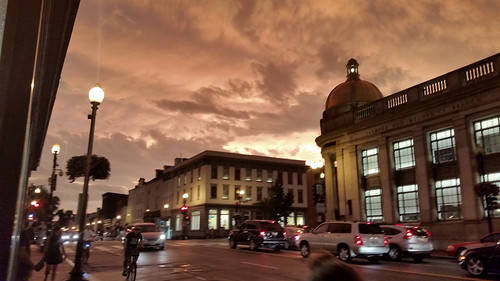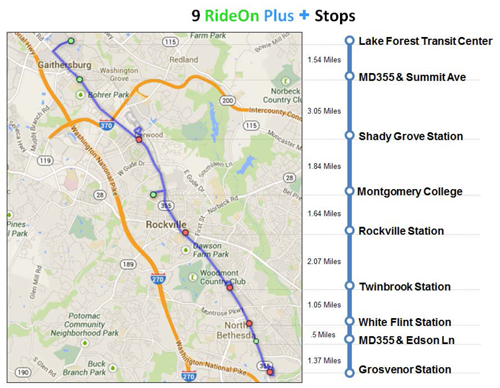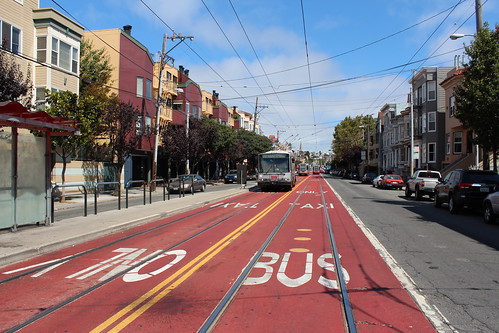|
Special Features





Image Libraries


|
|
Blog
Given how much Metrorail can transform a community, it’s little wonder communities want it to reach them. But planning and building new Metro lines is so politically and technically complex that it takes decades. Consider the Silver Line:

Slide from WMATA.
This slide showing a timeline of Silver Line planning and construction comes from a presentation WMATA planners Allison Davis and Kristen Haldeman gave at StreetsCamp this past Saturday.
The timeline begins in 1985, when the idea of a Metro line to Dulles Airport went from vague concept to serious planning initiative following a study that determined it would be feasible.
Planning (yellow on the timeline) and environmental work (green) took the next 21 years, until 2006. It took another 3 years for officials to finalize funding (blue) before construction (purple) could begin in 2009.
By the time the last segments open in 2019, it will have been 34 years.
Worth the wait, no doubt. But there’s bad news for other communities:
Plopping a rail line down the middle of a gargantuan suburban highway with a capacious median is easy compared to putting one virtually anywhere else. Almost any other potential Metrorail expansion imaginable will be harder to plan, fund, and build.
That doesn’t mean it’s not worth doing. But it’s definitely going to be hard.
 Cross-posted at Greater Greater Washington. Cross-posted at Greater Greater Washington.
Average Rating: 4.4 out of 5 based on 268 user reviews.
June 26th, 2015 | Permalink
Tags: metrorail, transportation

Maryland Governor Larry Hogan announced today the state will build the Purple Line.
Hogan announced his decision to build the light rail line at a press conference at 2:30 this afternoon.
To reduce costs, trains on the Purple Line will come every seven and half minutes rather than every six. The state will not change the alignment, nor the number or location of stations.
The Purple Line has been on the books for decades, and enjoys wide support in Maryland’s urban and suburban communities surrounding DC. It was primed to begin construction this year, but Governor Hogan has been threatening to cut it since entering office.
Our neighbors in Baltimore are not so lucky. At the same presser, Hogan announced the Baltimore Red Line will not move forward as currently conceived.
 Comment on this at the version cross-posted to Greater Greater Washington. Comment on this at the version cross-posted to Greater Greater Washington.
Average Rating: 4.6 out of 5 based on 263 user reviews.
June 25th, 2015 | Permalink
Tags: events, government, lightrail, transportation

Last night’s heavy storm produced a truly breathtaking evening sky. Here are seven spectacular photos from around the region.

M street, Georgetown.
According to Capital Weather Gang, the storm washed pollutants from the air at exactly the right moment. The clear air combined with dramatic clouds and red light from the sunset to produce the memorable view.
> Read more
 The rest of this post uses photos from the GGW Flickr pool. Therefore the full post only appears on Greater Greater Washington. The rest of this post uses photos from the GGW Flickr pool. Therefore the full post only appears on Greater Greater Washington.
Average Rating: 4.7 out of 5 based on 272 user reviews.
June 24th, 2015 | Permalink
Tags: environment, fun, galleries

Better streets, transit lines, and bike lanes are wonderful things. But for communities hoping to kick the car habit, good marketing and public relations matter just as much as the infrastructure itself.
At StreetsCamp on Saturday, Mobility Lab’s Paul Mackie taught us why marketing is crucial, and how to do it right.
Once upon a time, we walked
Once upon a time, there was an easy, cheap, and effective way to travel around cities. It was called walking. And then about 100 years ago one of the most effective public-relations campaigns in the history of mankind convinced everyone that streets belong to cars, and walking is dangerous.
Perception became reality, and a century later we’re still dealing with the consequences:

Implied message: You’re better off if you just drive. Image from MWCOG.
Does that ad make you want to walk safely? No. It makes you want to drive. Chalk one up for unintended consequences.
Here’s another example:
It doesn’t have to be that way. Here’s Mackie’s straightforward rule for doing it right:
What kind of “positive, personal stories?” How about Arlington’s Car-Free Diet campaign:

Image from Arlington.
You can even be positive while talking about safety, like in Arlington’s Be a PAL campaign.

Image from Arlington.
Once you’ve got a story to tell, how do you get it out there? Mackie has a guide for that too:
Following that guide is part of Mobility Lab’s formula for success. And yes, it works. It really works: It takes 40, 900 cars off Arlington’s roads every day.
 Cross-posted at Greater Greater Washington. Cross-posted at Greater Greater Washington.
Average Rating: 4.4 out of 5 based on 152 user reviews.
June 23rd, 2015 | Permalink
Tags: in general, transportation

Montgomery County is hoping a federal grant will jump-start its proposed BRT network with a new bus line on the county’s biggest main street, Route 355. If the grant comes through, the new “Ride-On Plus” won’t be full BRT, but will rather be a limited-stop route akin to WMATA’s MetroExtra.

Ride-On Plus route map. Image from Montgomery County.
Last month, Montgomery County submitted a grant request to the federal government for approximately $20 million to add a new bus line along busy Route 355. The line would run from Lakeforest Mall in Gaithersburg south to downtown Bethesda, making stops at key locations along the way in Gaithersburg, Rockville, and North Bethesda.
Buses would come every 10 minutes at peak times, and would only make a total of 9 stops over the course of the 11-mile route. By stopping so infrequently, buses would travel the route significantly faster than existing Ride-On buses.
Although Ride-On Plus will not qualify as bus rapid transit—it won’t have dedicated lanes—it will include some BRT-like upgrades: Traffic signals will stay green a few seconds longer if a bus is about to pass, and bus stops will have premium features like real-time arrival screens.
The grant is a long shot
Unfortunately, Ride-On Plus may never happen. County officials hope a federal TIGER grant will cover $18.5 million out of the project’s total $23 million price tag. But TIGER grants are extremely hard to come by; the federal TIGER budget is $500 million nationwide, and there are usually tens of billions of dollars in requests. Most grant requests never get money.
But if this grant comes through, Ride-On Plus could provide a nice first-step towards an eventual bona fide BRT line, helping to build ridership and make the case that there’s a market for better transit in Montgomery County.
 Cross-posted at Greater Greater Washington. Cross-posted at Greater Greater Washington.
Average Rating: 4.4 out of 5 based on 225 user reviews.
June 19th, 2015 | Permalink
Tags: bus, transportation

By Spring 2016, a four block stretch of Georgia Avenue near Howard University will feature DC’s first red-painted bus lanes.

Location of bus lanes. Image from DDOT.
At a community meeting last night, officials from DDOT announced they will reconfigure Georgia Avenue between Barry Place and Florida Avenue, converting two car lanes to curbside bus lanes, adding a center left turn lane, and improving the sidewalks, bus stops, street lighting, and traffic signals. Construction will begin in mid July of this year, and should wrap up by next Spring.

Detailed plans for part of the bus lanes. Image from DDOT.
The plan finally implements a concept DDOT planners originally conceived in 2010, as part of a federal grant for a series of bus improvements around the region 2007, as part of the Great Streets Initiative. Until recently, the last anyone had heard of this project was a public meeting back in 2012. But with the federal money due to expire in 2016, it’s now do or die for DDOT.
Ride the red carpet
Although it’s a short four blocks, this will become DC’s most significant bus lane yet. It will feature a bright red surface, providing the same kind of high-visibility as DC’s now common green bike lanes.

San Francisco red carpet. Photo from Matt’ Johnson.
According to DDOT officials, the red carpet will be the last thing construction crews install. They’ll let the bus lane operate for a month or so without it, to form a baseline that planners can look back against later, helping inform the agency about the effectiveness of the red paint.
Bikes and taxis will be allowed to use the bus lanes, and cars will be permitted to enter for up to 40 feet at a time, strictly to make right turns.
Buses already carry about half of all trips on Georgia Avenue. With bus lanes in place, that number could grow even higher.
If only the project were longer than four blocks.
 Cross-posted at Greater Greater Washington. Cross-posted at Greater Greater Washington.
Average Rating: 4.8 out of 5 based on 240 user reviews.
June 18th, 2015 | Permalink
Tags: bus, transportation

DC’s population is rising overall. But amid that rise, hundreds of thousands of people have come or gone since the year 2000. Among those who have left, inadequate housing is by far the biggest single reason.

Image from the DC Office of Revenue Analysis.
According to survey data summarized in this report from the DC Office of Revenue Analysis, 937, 115 people have moved out of DC since the year 2000. 36% of them, 338, 000, cite a housing-related category as the reason why.
Some respondents say directly they needed cheaper housing. Others say they wanted newer housing, or better housing, or to own instead of rent. But the common denominator is that DC’s housing stock is inadequate, and that inadequacy is stifling the District’s population growth, as thousands who’d otherwise prefer to stay move away.
Every time some government agency restricts the housing market’s ability to meet DC’s tremendous demand, they make this problem worse. Every time the zoning commission downzones rowhouse neighborhoods, or every time a review board lowers a proposed building’s height, DC’s housing market becomes a little bit worse than necessary.
Over time as each restriction builds on the last, competition for the limited housing that’s available rises, prices shoot up, and the city’s less affluent populations are squeezed out.
It’s true that DC can never be all things to all people. For example, DC will never be able to supply as many large lot subdivisions as upper Montgomery County. But many types of housing that DC can absolutely supply are being unnaturally and unnecessarily restricted.
It’s a horrible situation.
What about schools?
DC’s inadequate schools are without a doubt also a major reason some people leave the District. According to Yesim Sayin Taylor of the Office of Revenue Analysis, we don’t know how many residents have left because of schools because the survey, which wasn’t designed specifically for DC, didn’t ask that question.
Presumably respondents who left because of schools cited something more general like “other family reason” or “wanted better neighborhood.”
 Cross-posted at Greater Greater Washington. Cross-posted at Greater Greater Washington.
Average Rating: 4.4 out of 5 based on 155 user reviews.
June 12th, 2015 | Permalink
Tags: demographics, development, economy, government, law, preservation

|
Media





Site
About BeyondDC
Archive 2003-06
Contact
Category Tags:
Partners
|

 Cross-posted at Greater Greater Washington.
Cross-posted at Greater Greater Washington.





















